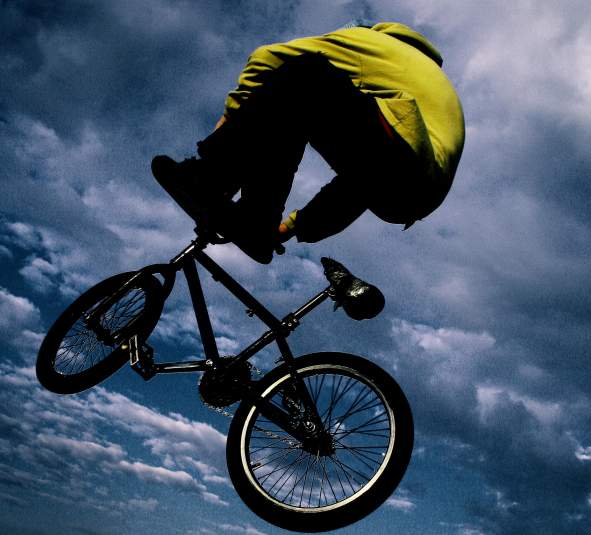
In a subjective world, perceptions are everything. How people see things is as important as what those things are in and for themselves because it’s human nature to interpret the world around us in the context of our own biases.
With that it mind, we can look at cycling, not for what it is, but for how it appears. Appearances are determined by norms, by what people expect and what they have grown accustomed to.
Take for instance the commonly held view of cycling as a dangerous activity. The activity itself isn’t particularly dangerous, when done in isolation. Few people imagine cyclists riding down a suburban bike path as being in imminent danger. The same holds true for cyclists riding in any controlled setting.
Danger enters the picture when bicycles are viewed in the context of traffic. By associating the consequences of mishandling a several ton motorized box of metal with the frailty of the human body, we arrive at the perception of traffic as dangerous. For this reason, when cyclists ride in traffic, the activity of cycling is suddenly perceived as dangerous.
The view of cycling as dangerous has real implications for cyclists beyond the obvious ones related to safety. These implications come about due to the human tendency to make value judgments. It’s not enough for the average person to regard cycling in traffic as dangerous, they feel compelled to extend that belief to who they think a particular cyclist is.
Most people observing a cyclist riding in traffic begin by asking themselves what kind of person would do such a foolhardy thing? Viewing the behavior as foolhardy actually tells us more about the observer than the cyclist. The observer, in accordance with his or her perceptions of the activity as dangerous, has determined that only a fool would take such risks — risks the observer wouldn’t take himself.
The fact that observers are projecting their own views on strangers never enters their mind since most people imagine everyone else just as they imagine themselves. In other words, they draw upon their own experiences, and personal choices, to judge others.
For cyclists, this is a double-edged sword. Not only do others judge them in light of their own beliefs, but they assign blame for things beyond a cyclist’s control. If a driver can’t see a cyclist at night, the driver’s first thought is that the cyclist is irresponsible. In reality, the cyclist may not own the gear necessary to enhance visibility. This could be due to low usage of the bicycle or financial hardship.
Of course, one would hope that cyclists would purchase and use front and rear lights, reflectors and high visibility clothing for riding in traffic, out of self-preservation. In contradiction to the prevailing view, a cyclist may ride a bike without making himself seen, counting instead on the illumination from headlights and street lights to keep him safe.
While this might work some of the time, when it fails, and the cyclist runs into a problem, blame will be attributed to the cyclist’s behavior. Most observers would conclude that a responsible cyclist should take steps to make himself visible, rather than depending on the actions and reactions of others. This, of course, works against a cyclist.
Take, for instance, what happens when a cyclist is involved in an accident with a car. The first thing people ask is “was the cyclist wearing a helmet.” In part, this reaction is provoked by the generally held belief in helmets as protective devices. As a result of valuing human life, most people would associate protective devices as evidence of responsible behavior; any responsible person would take steps to avoid injury, particularly to something as vital to survival as the brain.
Whether helmets protect the brain in crashes is debated among cyclists — although, interestingly, less so among non-cyclists. Individual cyclists can hold views on either side of the argument, and can govern their own behavior accordingly. But, what they can’t control is perceptions about who they are, based on their decision.
In a world immersed in perceptions, what’s important is not whether helmets save lives, but whether helmets save cyclists.
Helmets save cyclists in a variety of ways, the most important of which lies in the realm of illusions. Helmets create an illusion which translates into a protective shield against culpability. In other words, whether or not it protects one part of the body, namely the head, it protects the cyclist’s entire being by casting him as a person worthy of respect. This, like all perceptions is a value judgment, but one which calls for further analysis of a situation involving conflict.
The analysis, which is a search for truth, removes the cyclist’s personality from the equation. The cyclist now comes across as a responsible individual who would never take unnecessary risks which would result in self-harm.
Naturally, this is nothing more than an illusion. Neither a helmet nor a light can tell us who a cyclist is. But, they can tell us what a cyclist is not; she is not a fool.
Intelligent cyclists create illusions of responsibility to protect themselves from liability and to give them stronger standing when injured by a driver’s negligence. Well orchestrated illusions focus attention elsewhere and give a cyclist a fighting chance to hold an offending party accountable for causing injury or death.
Next time a cyclist sets forth the argument that helmets are useless and should not be worn, remember that this theory is based on beliefs, an interpretation of data, and views about the consequences of harm to the head. Still, no matter how vehemently they argue, few people will be persuaded because one illusion is worth a thousand words.


